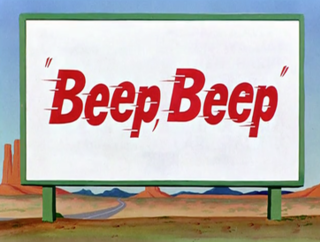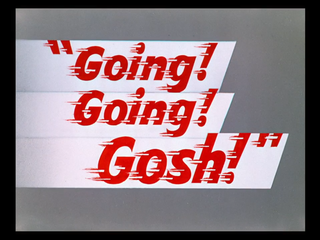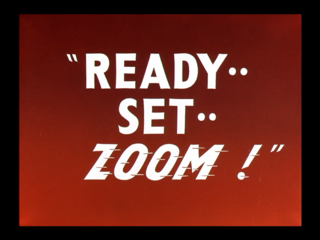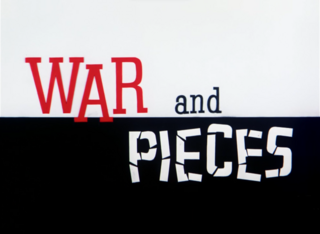Related Research Articles

Wile E. Coyote and the Road Runner are a duo of cartoon characters from the Looney Tunes and Merrie Melodies series of animated cartoons, first appearing in 1949 in the theatrical cartoon short Fast and Furry-ous. In each episode, the cunning, devious and constantly hungry coyote repeatedly attempts to catch and subsequently eat the Road Runner, but is always risibly unsuccessful in doing so. Instead of his animal instincts, the coyote uses absurdly complex contraptions to try to catch his prey. They comically backfire, with the coyote often getting injured in slapstick fashion. Many of the items for these contrivances are mail-ordered from a variety of companies implied to be part of the Acme Corporation.
Hopalong Casualty is a 1960 Warner Bros. Looney Tunes theatrical animated short, directed by Chuck Jones. The short was released on October 8, 1960, and stars Wile E. Coyote and the Road Runner. The title is a play on the Hopalong Cassidy western series of books written by author Clarence E. Mulford.
Beep Prepared is a 1961 Warner Brothers Merrie Melodies American theatrical cartoon short directed by Chuck Jones and designer Maurice Noble. The short was released on November 11, 1961, and stars Wile E. Coyote and the Road Runner. The title is a play on the Boy Scouts of America motto "Be Prepared".

To Beep or Not to Beep is a Merrie Melodies animated short starring Wile E. Coyote and the Road Runner. Released on December 28, 1963, the cartoon was written by Chuck Jones, John Dunn, Michael Maltese, and directed by Jones, Maurice Noble and Tom Ray receive credit as co-directors. This is the penultimate Road Runner/Wile E. Coyote short that Chuck Jones directed at Warner Bros. during the original "classic" era. This is also the final Warner Bros. cartoon released in 1963.

Beep, Beep is a 1952 Warner Bros. Merrie Melodies series directed by Chuck Jones. The short was released on May 24, 1952, and stars Wile E. Coyote and the Road Runner. The cartoon is named after the sound the Road Runner makes, which is also known as "Meep, meep".

Going! Going! Gosh! is a 1952 Warner Bros. Merrie Melodies cartoon directed by Chuck Jones. The short was released on August 23, 1952, and stars Wile E. Coyote and the Road Runner.

Zipping Along is a 1953 Warner Bros. Merrie Melodies cartoon directed by Chuck Jones. The short was released on September 19, 1953, and stars Wile E. Coyote and the Road Runner.

Ready, Set, Zoom! is a 1955 Warner Bros. Looney Tunes cartoon directed by Chuck Jones. The short was released on April 30, 1955, and stars Wile E. Coyote and the Road Runner.

Guided Muscle is a 1955 Warner Bros. Looney Tunes cartoon directed by Chuck Jones. The short was released on December 10, 1955, and stars Wile E. Coyote and the Road Runner.

Scrambled Aches is a 1957 Warner Bros. Looney Tunes cartoon directed by Chuck Jones. The short was released on January 26, 1957, and stars Wile E. Coyote and the Road Runner. The title is a pun on scrambled eggs.

Zoom and Bored is a 1957 Warner Bros. cartoon, being a part of the Merrie Melodies series and directed by Chuck Jones. The short was released on September 14, 1957, and stars Wile E. Coyote and the Road Runner.

Whoa, Be-Gone! is a 1958 Warner Bros. Merrie Melodies cartoon directed by Chuck Jones. The short was released on April 12, 1958, and stars Wile E. Coyote and the Road Runner.
Run, Run Sweet Roadrunner is a 1965 Warner Bros. Merrie Melodies cartoon directed by Rudy Larriva. The short was released on August 21, 1965, and stars Wile E. Coyote and the Road Runner.
Zoom at the Top is a 1962 Merrie Melodies cartoon directed by Chuck Jones and designer Maurice Noble. The short was released on June 30, 1962, and stars Wile E. Coyote and the Road Runner.

Gee Whiz-z-z-z-z-z-z is a 1956 Warner Bros. Looney Tunes cartoon directed by Chuck Jones. The short was released on May 5, 1956, and stars Wile E. Coyote and the Road Runner.
Fastest with the Mostest is a 1960 Warner Bros. Looney Tunes cartoon directed by Chuck Jones. The short was released on January 19, 1960, and stars Wile E. Coyote and the Road Runner.
Road Runner a Go-Go is a 1965 Warner Bros. Merrie Melodies cartoon directed by Chuck Jones, Maurice Noble and Tom Ray. It is one of three cartoons reused from the unsold pilot Adventures of the Road Runner. The short was released on February 1, 1965, and stars Wile E. Coyote and the Road Runner.

Hare-Breadth Hurry is a 1963 Warner Bros. Looney Tunes cartoon directed by Chuck Jones and Maurice Noble. The cartoon was released on June 8, 1963, and stars Bugs Bunny and Wile E. Coyote. This is the fifth and final pairing of Bugs and the Coyote, and unlike the previous four outings, this cartoon follows the Wile E. Coyote and Road Runner formula. While Wile E. Coyote is silent, Bugs speaks often to the audience. Hare-Breadth Hurry is also one of the few cartoons where Bugs does not eat a carrot, although Wile E. does use carrots as bait.

War and Pieces is a 1964 Warner Bros. Looney Tunes theatrical animated short directed by Chuck Jones. The short was released on June 6, 1964, and stars Wile E. Coyote and the Road Runner. It was the last Looney Tunes/Merrie Melodies cartoon directed by Chuck Jones until 1979's Freeze Frame.
Rushing Roulette is a 1965 Warner Bros. Merrie Melodies cartoon directed by Robert McKimson. The short was released on July 31, 1965, and stars Wile E. Coyote and the Road Runner. It was the second Road Runner cartoon directed by someone other than Chuck Jones, who had almost exclusively used the characters since their debut in 1949. McKimson directed one other Road Runner cartoon the following year, Sugar and Spies.
References
- ↑ Beck, Jerry; Friedwald, Will (1989). Looney Tunes and Merrie Melodies: A Complete Illustrated Guide to the Warner Bros. Cartoons. Henry Holt and Co. p. 332. ISBN 0-8050-0894-2.
- ↑ Lenburg, Jeff (1999). The Encyclopedia of Animated Cartoons . Checkmark Books. pp. 128-129. ISBN 0-8160-3831-7 . Retrieved 6 June 2020.